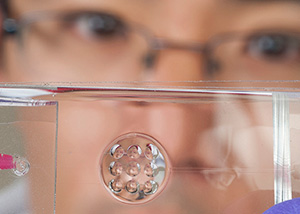Innovative new liquid lens switches between wide-angle insect view and human eye perspective
posted Thursday, September 19, 2013 at 4:23 PM EDT

Researchers at Ohio State University are the latest to explore the possibility of creating camera lenses that mimic the wide-angle way in which insects view the world. But in an intriguing twist that could have far reaching implications for photographers, the experimental lens would also have the focusing ability of a human eye, letting it capture images with depth, as well.
Or in other words, the liquid-based lens can quickly switch from wide-angle to zoomed-in, while having total control over depth of field much like a human eye, which can focus on close-ups, with distant objects remaining blurry.
“Our eye can change focus. An insect eye is made of many small optical components that can’t change focus but give a wide view. We can combine the two,” said Yi Zhao, associate professor of biomedical engineering and ophthalmology at Ohio State. “What we get is a wide-angle lens with depth of field.”
The prototype lens is made from flexible, transparent polymer filled with a gel-like fluid similar to what's inside a human eye. The experimental optic is composed of several, individual, dome-shaped fluid pockets, with small domes on top of larger domes. As the gelatinous fluid is pumped into and out of the lens, different domes expand and contract to change its shape and, as a result, shift the direction and focus of the lens.
By having a multi-purpose, "shape-changing lens," it would eliminate the need to use multiple lenses, allowing for smaller camera and microscope systems, researchers said. In one test, Zhao and an assistant were able to get the lens to switch its focus between the letters O-H-I-O printed on the tops of tiny platforms at varying heights. The prototype lens could lock in on each minuscule letter while the others remained blurry in the background.
Possible applications of the multi-part, liquid lens would be for smartphones, which could offer multiple perspectives and focal lengths, much like an interchangeable lens camera, but with a single, small optic. You can read more about the patent-pending lens in the Technical Digest of the 25th IEEE International Conference on Micro Electro Mechanical Systems.
The Ohio State lens is similar to an innovative optic we told you about in May, which is based on the compound eyes of insects. That lens, which was created by an international research team, did not have the ability to switch between an insect and human perspective, however.
(Via Ohio State University and Biomimicry News)